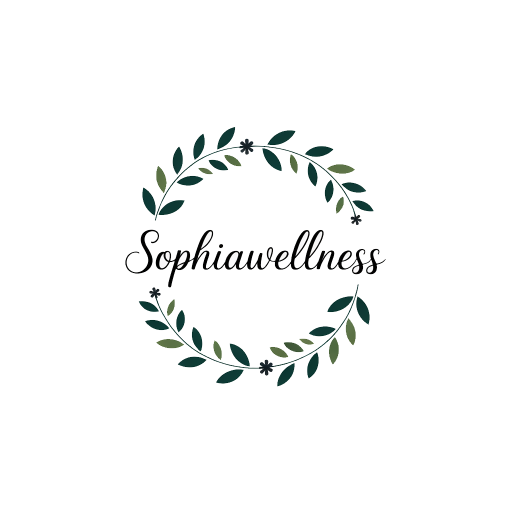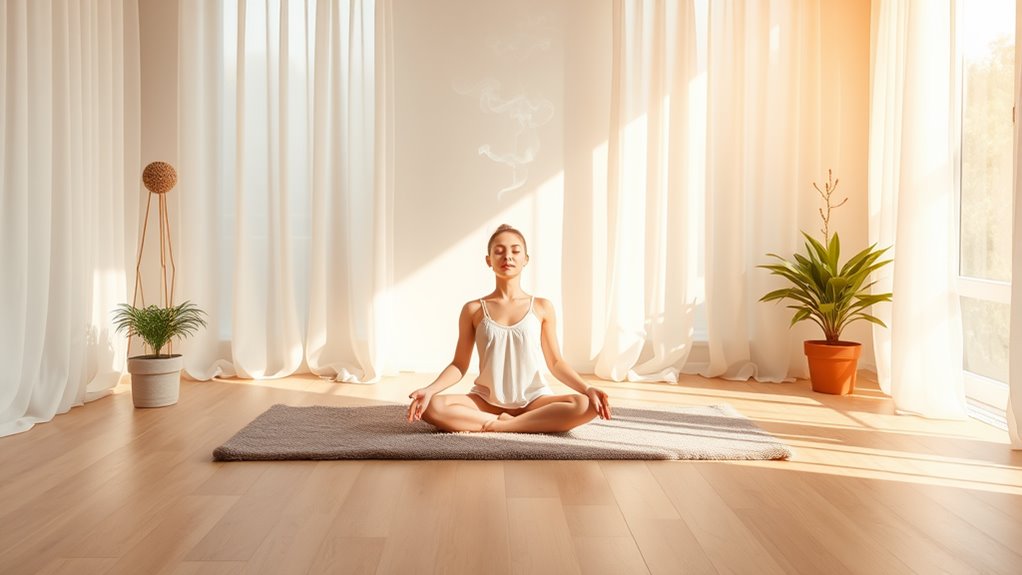The Best Breathing Exercises for Inner Peace and Calm
To find inner peace and calm, try these breathing exercises. Start with diaphragmatic breathing to reduce stress and enhance focus. Use the box breathing technique to cultivate tranquility or the 4-7-8 method for deeper relaxation. Don’t forget alternate nostril breathing for clarity and balance. You can also explore loving-kindness breathing and guided visualization breathing for a serene mental space. Discovering these techniques can transform how you manage stress and connect with yourself. More insights await you!
Key Takeaways
- Diaphragmatic breathing activates relaxation, reduces stress, and enhances emotional regulation for inner peace.
- Practice box breathing to cultivate tranquility by inhaling, holding, exhaling, and pausing in equal measures.
- Use the 4-7-8 method for calming the mind by focusing on deep, structured breaths.
- Alternate nostril breathing promotes balance and clarity while enhancing focus and mental tranquility.
- Guided visualization breathing combines deep breaths with peaceful imagery to release tension and foster relaxation.
Understanding the Importance of Breath
While you may not realize it, your breath is a powerful tool for achieving inner peace. Mastering your breathing can greatly enhance your meditation practice. Each inhale and exhale anchors you to the present moment, allowing you to cultivate a deeper sense of awareness.
When you focus on your breath, you clear your mind of distractions, creating a fertile ground for clarity and calm. This intentional breathing fosters a connection between your body and mind, enabling you to release tension and embrace tranquility. Incorporating breathing exercises into your routine can significantly improve your stress management skills.
As you develop this skill, you’ll discover how essential breathwork is in steering through life’s challenges. Commit to integrating mindful breathing into your daily routine, and watch as it transforms your meditation practices and overall well-being.
Diaphragmatic Breathing
Diaphragmatic breathing offers numerous benefits, from reducing stress to improving lung capacity. You can easily learn techniques to practice this method and incorporate it into your daily routine. This technique can help you breathe easy and achieve instant calm during moments of anxiety or tension.
Benefits of Diaphragmatic Breathing
Breath is your body’s anchor, and mastering diaphragmatic breathing can transform how you experience stress and anxiety.
By engaging your diaphragm, you tap into a powerful tool that promotes deep relaxation and enhances your overall well-being. Studies show that deep breathing techniques can significantly reduce stress levels and improve mental clarity.
Here are some key benefits you’ll experience:
- Reduced stress levels: Activate your body’s relaxation response.
- Improved oxygen exchange: Enhance lung capacity and efficiency.
- Lowered heart rate: Achieve a calmer physiological state.
- Enhanced focus: Clear your mind and sharpen concentration.
- Better emotional regulation: Cultivate a sense of inner peace.
Techniques for Practice
To effectively harness the power of diaphragmatic breathing, you’ll want to incorporate specific techniques that make the practice both accessible and rewarding.
Start by finding a comfortable position, either seated or lying down. Place one hand on your chest and the other on your abdomen. Inhale deeply through your nose, allowing your diaphragm—rather than your chest—to expand. Feel your abdomen rise as you fill your lungs.
Hold for a moment, then exhale slowly through pursed lips, feeling your abdomen lower. Aim for a smooth, rhythmic pattern. Research shows that combining breathing techniques with meditation can enhance overall well-being.
Practice this technique for five to ten minutes daily. As you become more familiar, integrate it into moments of stress or anxiety, reinforcing the calming benefits of diaphragmatic breathing in your life.
Incorporating Into Daily Routine
Integrating diaphragmatic breathing into your daily routine can considerably enhance your sense of inner peace.
By consciously practicing this technique, you’ll cultivate a deeper connection to your body and mind, empowering you to face daily challenges with ease. Additionally, consistent practice of breathing techniques can help reduce stress and promote overall well-being.
Here’s how to effortlessly incorporate it:
-
Morning Ritual: Start your day with five minutes of focused breathing.
-
Breaks at Work: Take short, mindful breathing breaks between tasks.
-
Pre-Sleep Routine: Wind down at night with calming breaths to improve sleep quality.
-
Mindfulness Practice: Pair diaphragmatic breathing with meditation for heightened awareness.
-
Physical Activity: Use it during workouts to enhance endurance and relaxation.
Box Breathing Technique
Four simple steps define the Box Breathing Technique, making it an effective method for achieving inner calm. By mastering this technique, you can enhance focus and reduce stress. Here’s how it works:
| Step | Action |
|---|---|
| Inhale | Breathe in deeply for 4 seconds |
| Hold | Retain breath for 4 seconds |
| Exhale | Exhale slowly for 4 seconds |
| Hold | Pause for 4 seconds before inhaling again |
Repeat this cycle several times. As you practice, you’ll cultivate a sense of tranquility and clarity. The structured rhythm of Box Breathing allows you to ground yourself, making it a powerful tool for maneuvering through life’s challenges. Embrace this technique, and watch your inner peace flourish.
4-7-8 Breathing Method
The -8 Breathing Method is a simple yet powerful technique that can enhance your relaxation.
You’ll learn the steps to practice this method effectively, making it a valuable addition to your daily routine.
Let’s explore how it can bring you a sense of calm and inner peace.
Steps to Practice
To cultivate inner peace through the -8 breathing method, you’ll want to follow a few simple steps.
Begin by finding a comfortable position, either sitting or lying down.
- Close your eyes and relax your shoulders.
- Inhale deeply through your nose for a count of four.
- Hold your breath for a count of eight.
- Exhale slowly through your mouth for a count of eight.
- Repeat this cycle for several minutes.
Stay focused on your breath, letting go of distractions.
If your mind wanders, gently bring it back to the rhythm of your breathing.
With practice, you’ll find this method enhances your ability to maintain calm and focus, allowing inner peace to flourish.
Benefits for Relaxation
Regularly practicing the -8 breathing method can greatly enhance your relaxation experience. This technique helps you release tension, lower your heart rate, and bring a sense of calm to your mind. By focusing on your breath, you cultivate mindfulness, allowing stress to melt away.
| Benefit | Description | Impact |
|---|---|---|
| Reduces Anxiety | Lowers cortisol levels | Promotes mental clarity |
| Enhances Focus | Improves concentration | Boosts productivity |
| Promotes Sleep | Encourages deeper, restful sleep | Increases overall well-being |
| Lowers Blood Pressure | Calms the nervous system | Supports heart health |
| Fosters Mindfulness | Encourages present-moment awareness | Enhances emotional resilience |
Embrace the -8 breathing method, and you’ll master relaxation like never before.
Alternate Nostril Breathing
While you may be seeking calm amidst the chaos of daily life, alternate nostril breathing offers a simple yet effective technique to promote inner peace. This practice harmonizes your mind and body, balancing the left and right hemispheres of your brain.
To master this technique, follow these key steps:
- Sit comfortably with a straight spine.
- Use your right thumb to close your right nostril.
- Inhale deeply through the left nostril.
- Close the left nostril with your right ring finger, release the right nostril, and exhale through it.
- Inhale through the right nostril, then switch to exhale through the left.
Incorporate this practice into your routine, and you’ll cultivate a profound sense of tranquility and clarity.
Ocean Breathing (Ujjayi Pranayama)
Following the calming effects of alternate nostril breathing, ocean breathing, or Ujjayi Pranayama, can deepen your sense of tranquility. This technique involves slightly constricting your throat while breathing, creating a soothing sound reminiscent of ocean waves. To master this practice, find a comfortable seated position and focus on your breath.
| Step | Action | Focus |
|---|---|---|
| Inhale | Deeply through your nose | Feel the breath expand |
| Exhale | Slowly through your mouth | Release tension softly |
| Repeat | For several minutes | Maintain awareness of sound |
Incorporate ocean breathing into your routine, and you’ll cultivate a profound sense of calm and presence in your daily life.
Progressive Relaxation Breathing
Progressive Relaxation Breathing is a powerful technique that helps you release tension in your body and mind.
You’ll learn to systematically relax each muscle group, making it easier to find calm in your daily life.
Understanding this method can lead to significant stress relief and a deeper sense of inner peace.
Understanding Progressive Relaxation
As you seek to cultivate inner peace, understanding progressive relaxation can be a valuable tool in your journey. This technique focuses on systematically tensioning and relaxing muscle groups, allowing you to gain awareness of physical sensations and stress.
By honing this skill, you can effectively release tension and promote a serene mind.
Consider these key aspects of progressive relaxation:
- Enhances body awareness, helping you identify stress points
- Encourages deep, rhythmic breathing for ideal oxygen flow
- Reduces anxiety by quieting the mind and body
- Increases mental clarity through focused relaxation
- Fosters a sense of control over your physiological responses
Mastering progressive relaxation can serve as a foundation for achieving lasting tranquility and calm.
Step-by-Step Technique
Begin your journey into progressive relaxation breathing by finding a comfortable position, either sitting or lying down.
Close your eyes and take a deep breath in through your nose, feeling your abdomen expand. Hold this breath for a moment, then exhale slowly through your mouth, releasing tension.
Now, focus on one muscle group, like your feet. Inhale deeply, tensing that area for a few seconds. Exhale, letting go of the tightness.
Move up your body, repeating this process for your calves, thighs, abdomen, and so on, until you reach your head. With each exhale, visualize stress melting away.
Finish by taking a few calming breaths, embracing the tranquility you’ve cultivated through this powerful technique.
Benefits for Stress Relief
The technique of progressive relaxation breathing offers significant benefits for stress relief. By systematically tensing and relaxing your muscles while focusing on your breath, you cultivate a deep sense of calm that permeates your entire being.
This practice can help you master the art of relaxation and enhance your daily life.
- Lowers cortisol levels, reducing overall stress
- Promotes mindfulness, anchoring you in the present
- Improves sleep quality, fostering restorative rest
- Enhances emotional resilience, helping you handle challenges
- Increases self-awareness, connecting you to your body’s signals
Incorporating progressive relaxation breathing into your routine can empower you to navigate stress with grace and tranquility, transforming your mental state and nurturing your inner peace.
Breath Counting Meditation
Breath counting meditation is a simple yet powerful technique that can ground you in the present moment. To begin, find a comfortable position and close your eyes. Inhale deeply through your nose, and as you exhale, silently count “one.”
With each subsequent breath, count up to five, then start over. This practice sharpens your focus and cultivates mindfulness, allowing distractions to fade away. If your mind wanders, gently bring it back to your breath and your counting.
Aim for consistency; even a few minutes daily can deepen your mastery over this technique. Embrace the tranquility that arises as you develop a heightened awareness of your breath, transforming your meditation into a profound journey of self-discovery and inner peace.
Loving-Kindness Breathing
After honing your focus with breath counting meditation, you can enrich your practice through Loving-Kindness Breathing. This technique cultivates compassion and fosters emotional resilience, allowing you to connect deeply with yourself and others.
Here’s how to practice it effectively:
- Begin with a few deep breaths to center yourself.
- Silently repeat phrases like “May I be happy, may I be healthy.”
- Gradually extend these phrases to loved ones, acquaintances, and even those you find challenging.
- Visualize sending warmth and kindness with each exhale.
- Allow feelings of love and compassion to fill your heart.
Integrating Loving-Kindness Breathing into your routine not only enhances your meditation practice but also nurtures a profound sense of inner peace.
Guided Visualization Breathing
While you may feel overwhelmed by daily stressors, Guided Visualization Breathing offers a powerful way to create a serene mental space. This practice combines focused breathing with vivid imagery, allowing you to explore calming scenarios. As you inhale deeply, visualize a peaceful setting; as you exhale, release tension.
| Step | Action |
|---|---|
| 1. Get Comfortable | Find a quiet, comfortable spot |
| 2. Close Your Eyes | Block out distractions |
| 3. Breathe Deeply | Inhale through your nose |
| 4. Visualize | Imagine a serene landscape |
Resonant or Coherent Breathing
When you seek to cultivate a sense of calm and balance, Resonant or Coherent Breathing can be an effective technique. This method focuses on creating a steady rhythm in your breath, typically at a rate of five breaths per minute. By mastering this practice, you can enhance your physiological and psychological well-being.
- Promotes relaxation and reduces stress
- Improves heart rate variability
- Enhances mental clarity and focus
- Supports emotional regulation
- Fosters a deeper connection to your body
To engage with Resonant Breathing, inhale deeply through your nose for six seconds, then exhale through your mouth for six seconds. Repeating this cycle allows you to harmonize your body and mind, leading to profound inner peace.
Incorporating Breathing Exercises Into Daily Life
Incorporating breathing exercises into your daily routine can transform your overall well-being, especially as you navigate life’s challenges.
Start small—set aside a few minutes each morning to focus on your breath. You can practice deep diaphragmatic breathing while sipping your coffee or even during a work break.
Consider utilizing mindful breathing techniques during stressful moments; a quick five-count inhale and exhale can ground you instantly.
Make it a habit to check in with your breath throughout the day—this awareness fosters calm.
You might also try guided sessions in the evening to unwind.
Frequently Asked Questions
Can Breathing Exercises Help With Anxiety and Stress Relief?
When you practice breathing exercises, you’re like a ship steering through turbulent waters. They calm your mind, reduce anxiety, and relieve stress, helping you regain control and find your inner anchor amidst life’s storms.
How Often Should I Practice These Breathing Exercises?
You should practice breathing exercises daily, ideally for 5 to 10 minutes. Consistency builds mastery, so try integrating them into your routine, especially during stressful moments, to enhance their calming effects and overall benefits.
Are There Any Risks Associated With Breathing Exercises?
Did you know that 30% of people experience dizziness during breathing exercises? While most practices are safe, overexertion or improper technique can lead to risks. Always listen to your body and adjust accordingly for mastery.
Can Children Benefit From Breathing Exercises Too?
Absolutely, children can benefit from breathing exercises. They enhance focus, reduce anxiety, and promote emotional regulation. Introducing these techniques early helps them develop resilience and coping skills, setting a strong foundation for their mental well-being.
What Is the Best Time of Day to Practice Breathing Exercises?
The best time to practice breathing exercises is when you’re feeling stressed, when you’re seeking clarity, or when you’re winding down. Consistency matters, so choose a time that fits your daily routine and stick to it.





